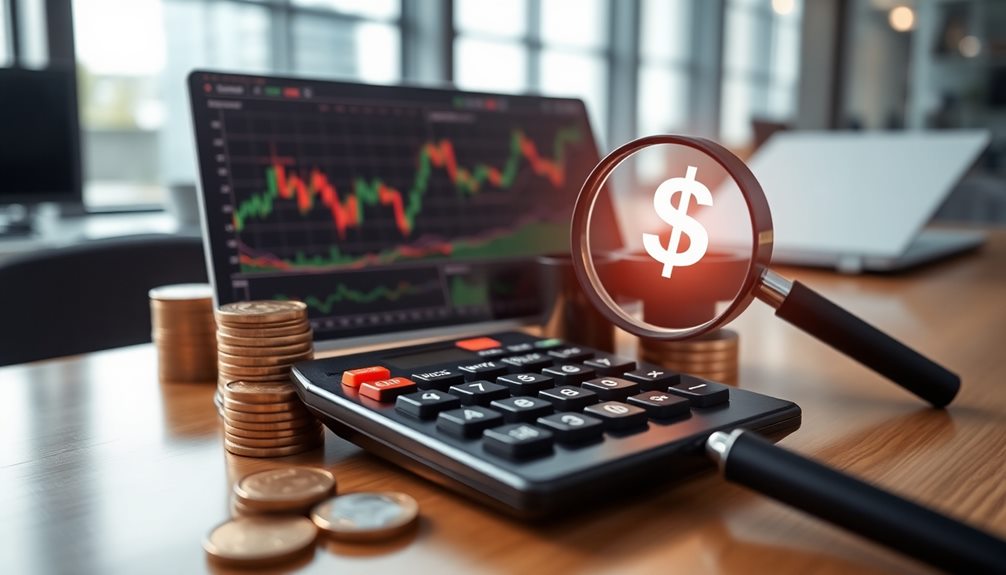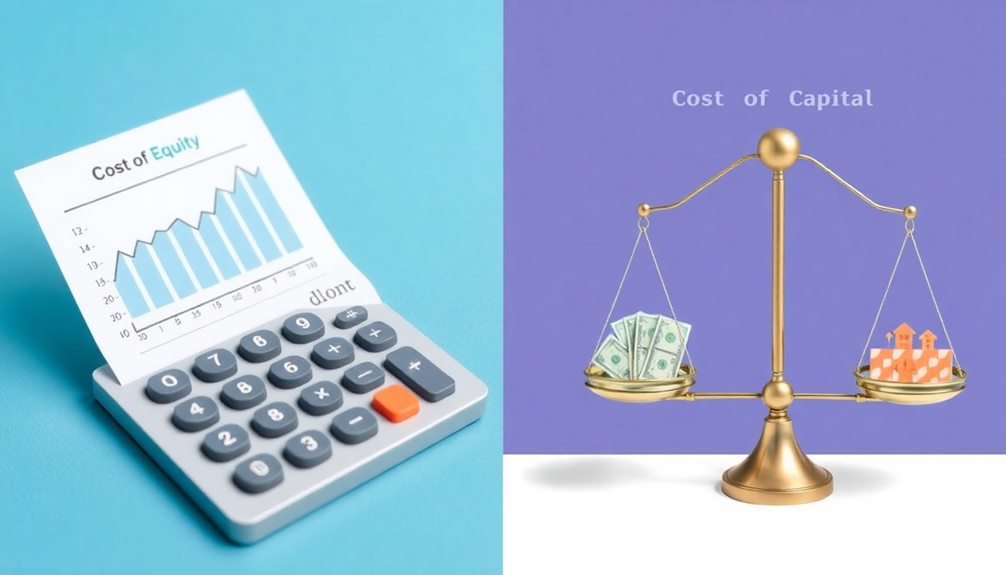The cost of equity represents the return you expect from equity investments, accounting for risk. You can calculate it using methods like the Dividend Discount Model (DDM) or the Capital Asset Pricing Model (CAPM). DDM focuses on dividends, while CAPM considers market volatility through beta. Understanding this cost is key for evaluating investment opportunities and capital structure decisions. A higher cost of equity typically signals greater risk, influencing your investment choices. Knowing how to determine and apply it can greatly impact your financial strategy. There's much more to explore to strengthen your investment acumen.
Key Takeaways
- Cost of equity represents the return required by equity investors, reflecting the financial risk associated with an investment.
- It can be calculated using methods like the Dividend Discount Model (DDM) or Capital Asset Pricing Model (CAPM).
- A higher cost of equity indicates increased investment risk, impacting investor decisions and stock purchase evaluations.
- Companies use the cost of equity to inform capital structure choices and overall cost of capital calculations.
- Understanding cost of equity is crucial for assessing investment opportunities and guiding financial strategies in dynamic markets.
Understanding Cost of Equity

Understanding the cost of equity is essential for anyone looking to make informed investment decisions. The cost of equity represents the return required by equity investors, reflecting the compensation they expect for the financial risks they take.
You can calculate this cost primarily through two methods: the Dividend Discount Model (DDM) and the Capital Asset Pricing Model (CAPM).
The DDM focuses on projected dividends, while the CAPM incorporates market risk through beta, which measures a stock's volatility compared to the market. In the CAPM formula, the risk-free rate, often approximated by Treasury yields, along with the equity market risk premium, are critical components influencing your cost of equity calculation.
A higher beta indicates a stock's greater volatility relative to the market, leading to a higher perceived risk and subsequently a higher cost of equity.
This understanding will help you evaluate investment opportunities more effectively. By grasping how the cost of equity interacts with market value and risk, you can make better strategic decisions regarding your investments and the capital structure of the companies you're considering.
Importance of Cost of Equity

The cost of equity plays a pivotal role in investment analysis, as it directly influences how investors assess the potential returns on their investments.
Understanding the importance of cost of equity is essential because it helps you gauge whether the expected returns on an investment justify the risks involved. When you consider investment opportunities, the required rate of return, often linked to the risk premium, becomes a critical factor.
A higher cost of equity typically indicates increased investment risk, which can alter your expectations and decisions regarding stock purchases.
Additionally, companies rely on an accurate calculation of the cost of equity to inform their capital structure decisions and overall cost of capital. This impact extends to the firm's valuation and financing strategies.
Methods for Calculating Cost of Equity

Often, investors use multiple methods to calculate the cost of equity, each offering unique insights into a company's financial health.
Here are the primary methods you might consider:
- Dividend Capitalization Model: This method calculates cost of equity using the formula: Cost of Equity = (Dividends per Share / Current Market Value) + Growth Rate.
- Capital Asset Pricing Model (CAPM): CAPM determines cost of equity as follows: Cost of Equity = Risk-Free Rate + Beta × (Expected Market Return – Risk-Free Rate). Here, beta measures the stock's volatility relative to the market.
- Earnings Capitalization Ratio: This alternative method calculates cost of equity by dividing Earnings per Share by Current Share Price.
- Fama-French Model: This model enhances CAPM by including additional factors like company size and value, providing a more nuanced view of equity costs.
Cost of Equity vs. Cost of Capital

When comparing cost of equity to cost of capital, it's important to grasp the distinctions between these two financial metrics. The cost of equity represents the returns required by equity investors, while the cost of capital encompasses both the cost of equity and the cost of debt. This gives you a clearer picture of the overall cost of financing for a company.
| Metric | Description | Importance |
|---|---|---|
| Cost of Equity | Returns required by equity investors | Essential for firms without debt |
| Cost of Capital | Combination of cost of equity and cost of debt | Relevant for firms using both |
| Weighted Average Cost of Capital (WACC) | Average cost reflecting capital structure | Guides investment strategies |
Typically, a company's cost of capital is lower than its cost of equity since debt financing is cheaper due to tax advantages and lower risk to creditors. When the cost of equity is around 8% and the cost of debt is 4%, companies often prefer debt financing. Understanding these differences is key to making informed decisions about capital structure and investment strategies.
Real-World Applications and Examples

Understanding the cost of equity is vital for making sound capital budgeting decisions. It guides your investment choices and helps determine whether to accept or reject projects based on expected returns.
Here are some real-world applications:
- Companies like Apple and Amazon utilize the Capital Asset Pricing Model (CAPM) to calculate cost of equity.
- High-growth sectors, such as technology, often face increased market risk, leading to higher costs of equity.
- Investors compare the cost of equity with historical returns to evaluate investment viability.
- Mergers and acquisitions rely on accurate cost of equity calculations to guarantee financial feasibility.
For instance, if you find a company's cost of equity is 10% while its historical return is 12%, it could be a sign of a solid investment opportunity.
In high-growth sectors, it's important to take into account the dividend growth rate and expected return, as these factors influence the cost of equity.
Accurately evaluating this cost helps you align your investment strategy with your financial goals, making sure you attract capital and make informed decisions in an ever-changing market.
Frequently Asked Questions
Why Is the Cost of Equity Important?
The cost of equity's important because it helps you understand the returns investors expect for taking risks. It guides your investment decisions, influences project evaluations, and affects company valuations, ensuring effective capital allocation.
What Is the Cost of Equity and How Is It Calculated?
The cost of equity represents the return you expect as an investor. You can calculate it using the Dividend Capitalization Model or the Capital Asset Pricing Model, which considers risk and market conditions to determine expected returns.
Is a Higher or Lower Cost of Equity Better?
You'd generally prefer a lower cost of equity, as it signals less risk and more attractive capital. A higher cost implies investors demand more returns, indicating potential volatility and greater uncertainty in your investment.
Why Do We Calculate Equity?
When you calculate equity, you assess potential returns, like Jane evaluating a startup. This guarantees you're aware of risks and rewards, guiding your investment decisions and helping you choose between financing options effectively.
Conclusion
In summary, grasping the cost of equity is like steering a ship through foggy waters; it's essential for guiding your investments in the right direction. Understanding how it's calculated and its significance can help you chart a course towards financial success. Just as a seasoned captain relies on accurate instruments, you should use this knowledge to make informed decisions, ensuring your company remains buoyant and profitable in the competitive seas of the market.










